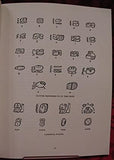Commentary on the Dresden Codex
Author: Forstemann, Ernst Wilhelm (1822-1906)
Year: 1992
Publisher: Aegean Park Press
Place: Laguna Hills, CA
Description:
xi+212 with figures and tables. Quarto (11" x 8 1/4") bound in original publisher's wrappers. Translated by Selma Wesselhoeft and A M Parker. Reprint of the Papers of the Peabody Museum of American Archaeology and Ethnology, Harvard University. Volume IV, number 2 (1906).
Johann Christian Gotze, Director of the Royal Library at Dresden, purchased the codex from a private owner in Vienna in 1739. How it came to Vienna is unknown. It is speculated that it was sent by Hernan Cortes as a tribute to King Charles I of Spain in 1519. Charles had appointed Cortes governor and captain general of the newly conquered Mexican territory. The codex has been in Europe ever since. In 1810, Alexander von Humboldt published five pages from the Dresden Codex in his atlas Vues des Cordillères, et monumens des peuples indigènes de l'Amérique. The state library of Saxony, the Royal Library in Dresden, first published the codex in 1848. It was not until 1853 that Charles Etienne Brasseur de Bourbourg identified the Dresden Codex as a Mayan manuscript. In 1835, the codex was placed between glass panes in two parts measuring 1.85 meters (6.1 feet) and 1.77 meters (5.8 feet) in length. Between 1880 and 1900, Dresden librarian Ernst Wilhelm Forstemann succeeded in deciphering the calendar section including the Maya numerals used in the codex. These numbers are based on a vigesimal (base-20) numeral system, made up of three symbols: zero (shell shape), one (a dot) and five (a bar). Important milestones in the subsequent decoding of the non-calendar section were the assignment of gods to specific glyphs by Paul Schellhas in 1897 and Yuri Knorozov's phonetic approach to deciphering in the 1950s. Knorozov's work was based on the De Landa alphabet, developed by Diego de Landa around 1566. The library that held the codex was bombed and suffered serious damage during the firebombing of Dresden in World War II. The Dresden Codex was heavily water damaged. The codex was meticulously restored; however, some of the pages were returned to the protective glass cabinet out of sequence. They have remained this way because the water damage caused some of the painted areas to adhere to the glass.
Condition:
Some light edge wear, small crease at front head corner else a better tham very good copy.
Year: 1992
Publisher: Aegean Park Press
Place: Laguna Hills, CA
Description:
xi+212 with figures and tables. Quarto (11" x 8 1/4") bound in original publisher's wrappers. Translated by Selma Wesselhoeft and A M Parker. Reprint of the Papers of the Peabody Museum of American Archaeology and Ethnology, Harvard University. Volume IV, number 2 (1906).
Johann Christian Gotze, Director of the Royal Library at Dresden, purchased the codex from a private owner in Vienna in 1739. How it came to Vienna is unknown. It is speculated that it was sent by Hernan Cortes as a tribute to King Charles I of Spain in 1519. Charles had appointed Cortes governor and captain general of the newly conquered Mexican territory. The codex has been in Europe ever since. In 1810, Alexander von Humboldt published five pages from the Dresden Codex in his atlas Vues des Cordillères, et monumens des peuples indigènes de l'Amérique. The state library of Saxony, the Royal Library in Dresden, first published the codex in 1848. It was not until 1853 that Charles Etienne Brasseur de Bourbourg identified the Dresden Codex as a Mayan manuscript. In 1835, the codex was placed between glass panes in two parts measuring 1.85 meters (6.1 feet) and 1.77 meters (5.8 feet) in length. Between 1880 and 1900, Dresden librarian Ernst Wilhelm Forstemann succeeded in deciphering the calendar section including the Maya numerals used in the codex. These numbers are based on a vigesimal (base-20) numeral system, made up of three symbols: zero (shell shape), one (a dot) and five (a bar). Important milestones in the subsequent decoding of the non-calendar section were the assignment of gods to specific glyphs by Paul Schellhas in 1897 and Yuri Knorozov's phonetic approach to deciphering in the 1950s. Knorozov's work was based on the De Landa alphabet, developed by Diego de Landa around 1566. The library that held the codex was bombed and suffered serious damage during the firebombing of Dresden in World War II. The Dresden Codex was heavily water damaged. The codex was meticulously restored; however, some of the pages were returned to the protective glass cabinet out of sequence. They have remained this way because the water damage caused some of the painted areas to adhere to the glass.
Condition:
Some light edge wear, small crease at front head corner else a better tham very good copy.















